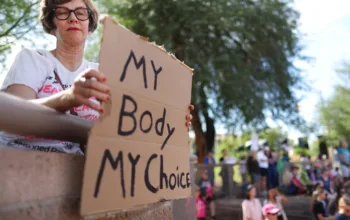The child tax credit expansion launched on July 15. It’s a big step, but it needs to be permanent.
Thursday, July 15, 2021, could wind up being one of the most important days in the history of American anti-poverty policy.
On this day, most parents in the United States began receiving monthly checks of up to $300 per child — no strings attached.
What’s technically happening: The child tax credit (CTC), a policy that has existed in some form since 1997, was expanded with the enactment of President Joe Biden’s American Rescue Plan, both in its size (going from $2,000 per child per year to $3,000 for children ages 6 through 17, and $3,600 for children under 6) and in its reach.
But calling this a “tax credit expansion” makes it seem less momentous than it is. It’s really a one-year test of an idea known as a child allowance, a policy that has been adopted in most rich countries besides the United States.
We know from the experiences of peer countries from Great Britain to Spain to Germany to Canada that child allowances can slash child poverty dramatically, and, as a consequence of reducing poverty, improve child health, increase parents’ time with their kids, and perhaps even raise incomes and extend life spans down the road for children who benefited.
The key to this policy’s success is that all poor families are eligible. Before this year, many poor children were deliberately excluded from the CTC on the theory that doing so would encourage their parents to work. Biden, as part of his stimulus plan and at the urging of poverty and child welfare advocates, signed into law an expansion to all poor families for tax year 2021.
/cdn.vox-cdn.com/uploads/chorus_asset/file/22675296/AP21162596891084.jpg) Manuel Balce Ceneta/AP
Manuel Balce Ceneta/APIf everyone eligible gets it, it could slash child poverty by 40 percent; add in stimulus payments and other Biden measures and child poverty would fall even more. But that depends on everyone eligible for the expanded CTC actually getting their checks, which will require massive outreach and government investment; more on this below.
If you’re reading this and are a parent to a child who’s a US citizen or resident immigrant, there are two ways to get the money.
You’ll get it automatically if you filed a 2019 or 2020 tax return (if you got stimulus checks for your kids last year and this spring, you’re good); if you didn’t file those years, or if you have a kid who was born after you filed, the IRS has set up a site to help you sign up. The nonprofit website GetYourRefund can also be helpful and can connect you with an IRS-certified volunteer to help you get your money.
The plan is for the IRS to send out monthly payments through the end of 2021. Because the monthly payments will only last from July to December, they won’t include the full value of the credit; the rest will be sent out with tax returns in April 2022.
That sets up a challenge for the Biden administration and Democrats in Congress. They want to make some or all of these changes to the child tax credit permanent, to have the monthly benefits not abruptly stop in January. But that will require quick action by Congress, and a successful rollout of the CTC right now.
It is hard to overstate the importance of the CTC expansion, not just to poverty in America but to Joe Biden’s legacy. If it sticks, it will be the largest, most important anti-poverty measure the US has taken since the Lyndon Johnson administration, and could stand as the most impactful domestic achievement of Biden’s presidency. It could earn recognition alongside Medicare, Medicaid, and Social Security as one of the Democratic Party’s most enduring and popular policies.
But it has to stick — and Biden and his allies in Congress need to act fast to make that happen.
A generous benefit, but will it get to everyone who needs it?
The vast majority of American parents — covering 39 million households, or 88 percent of households with children, per the Treasury Department — will receive the monthly payments automatically.
That still leaves out millions of households. Now, many of them are excluded because they make too much money. The credit starts phasing out at $112,500 annual gross income for most single parents and $150,000 for most married parents; the maximum income to receive some credit depends on the number of children in a household, but a married couple with two kids won’t see the credit go away until they reach $480,000 in income.
But others won’t receive the benefit automatically even though they’re eligible because they haven’t filed their taxes. A big challenge for proponents of this expanded benefit is making sure people who are eligible actually receive it. Compounding the challenge is that the population in greatest danger of not getting the benefit is also the one that happens to need it most.
Such obstacles are not uncommon in our notoriously kludgey welfare system: Even a long-established benefit like the earned income tax credit (EITC) — a refundable credit for which many low-income families are eligible — has a filing process that is sufficiently complicated that about a fifth of households eligible for that benefit don’t file to receive it.
The most important recipients of the expanded CTC from an anti-poverty perspective are extremely poor recipients who have literally $0 in taxable income. These potential CTC beneficiaries receive no benefit from the EITC because it’s reserved for families with “earned income.” Without any taxes to owe, or EITC to receive, these poor households generally don’t file their taxes and won’t get the CTC automatically.
Before this year, this population was also excluded from the child tax credit, which previously had an income floor of $3,000, with anyone below that entirely excluded (and those right above that threshold receiving a reduced credit).
Some people in this population filed to receive stimulus payments, which last year were available, for the first time in American history, to people with $0 in income — meaning they’re now slated to also automatically get the expanded CTC. But others did not. IRS data suggests that at least 2.3 million children in the US fall into this category. But that’s likely an undercount. “We know that number … excludes some children,” Kris Cox, deputy director for federal tax policy at the Center on Budget and Policy Priorities (CBPP), told me.
That figure — 2.3 million children — is a small fraction of the roughly 73 million total children in the US. But it may be a particularly vulnerable and low-income fraction, and it’s crucial that the IRS reach it. “Most likely, the people who will be missed are the very lowest incomes,” Elaine Maag of the Tax Policy Center, one of the country’s leading experts on the child tax credit, told me in an email.
So far, the results of the effort to find these potential recipients and sign them up have been mixed at best. Critics have lambasted the IRS’s website allowing non-filers to sign up for the CTC as confusing, hard to use, and impossible to navigate on a mobile phone. The Washington Post’s Michelle Singletary reports that community groups working on outreach have found the system frustrating; it’s web-based and requires email addresses, when the population these groups work with often has limited access to computers and the internet.
Maag notes that the Volunteer Income Tax Assistance (VITA) program could help non-filers navigate the system — but VITA is overburdened in good times and has been struggling to adapt to mostly online operation during the pandemic. (As a VITA volunteer, I can attest that trying to wrangle together W2s and Social Security cards online and over the phone was very tricky this year.)
To be fair to the IRS, this has been a very difficult period for the agency, with many new policies to implement with minimal resources, insufficient staffing, and not a lot of prep time. “The IRS had to deal with the filing season, everything that went on with unemployment compensation, getting stimulus payments out, etc.,” John Wancheck, a senior adviser on tax credit policy at CBPP, told me. “All of that is very complicated and late-breaking.”
That said, there’s more they can and should do to reach these groups. Chuck Marr, senior director of federal tax policy at CBPP, notes that state governments have a lot of information on non-filing low-income households from administering Medicaid and the Supplemental Nutritional Assistance Program (SNAP, or “food stamps,” colloquially). The IRS can and should be working with those governments to reach families with low or zero income to ensure they get a benefit that would be a big help.
The next step for policymakers: Making the child allowance permanent
Even more important over the long run than reaching the poorest households is making sure the child tax credit does not expire after a year.
The Biden CTC expansion is modeled after a bill embraced by most Democratic members of the House and Senate in 2019 known as the American Family Act. That act would have expanded the CTC to the same amounts as Biden ($3,000 per year for kids ages 6 to 17, $3,600 per year for under 6), made the credit available to people with no income (known as making it “fully refundable”), and paid it out monthly. All of that is in Biden’s plan.
But the AFA was a permanent policy, whereas Biden only implemented these improvements for one year.
Members of Congress behind the AFA are pushing hard to make these increases permanent as soon as possible. In a statement in April, its champions in the Senate (Michael Bennet (D-CO), Sherrod Brown (D-OH), and Cory Booker (D-NJ)) and the House (Rosa DeLauro (D-CT), Suzan DelBene (D-WA), and Ritchie Torres (D-NY)) declared, “Expansion of the Child Tax Credit is the most significant policy to come out of Washington in generations, and Congress has an historic opportunity to provide a lifeline to the middle class and to cut child poverty in half on a permanent basis. … Permanent expansion of the CTC will continue to be our priority.”
Bennet has said he will “fight like hell” for a permanent extension, and Senate Finance Chair Ron Wyden (D-OR) and House Ways and Means Chair Richard Neal (D-MA) are on board to make the policy permanent.
The Biden administration’s position has been subtler. Expanding the child tax credit costs money, and to make it permanent under Senate budget reconciliation rules (which enable passage with just 50 Democrats, rather than requiring 10 Republicans to get on board to break a filibuster), it needs to be offset with tax hikes or spending cuts elsewhere in the budget.
So Biden has proposed, as part of his American Families Plan, making the full refundability of the credit permanent, but only extending the expansion of the benefit amount to $3,000/$3,600 through 2025.
/cdn.vox-cdn.com/uploads/chorus_asset/file/22675308/GettyImages_1233580576.jpg) Brendan Smialowski/AFP/Getty Images
Brendan Smialowski/AFP/Getty Images/cdn.vox-cdn.com/uploads/chorus_asset/file/22675309/GettyImages_1232563263.jpg) Al Drago/Bloomberg/Getty Images
Al Drago/Bloomberg/Getty ImagesThis is a complicated idea, so let me walk through it a bit.
Under current law — that is, once the one-year expansion from the Biden stimulus elapses — the CTC will go back down to $2,000 per child, and stop being available to the poorest households in 2022. Parents will get the remainder of their 2021 credit when they file taxes, but monthly payments will cease in January 2022. Also under current law, it will fall to $1,000 per child in January 2026 — because that’s when the bulk of the Trump tax cuts, which expanded the credit to $2,000 per child from $1,000, expire.
Under congressional Democrats’ plan, the credit will stay at $3,000/$3,600, paid out monthly, and stay available to the poorest households forever.
Under the Biden plan, the $3,000/$3,600 amounts would continue through January 2026. Then the credit would fall to $1,000 per child. But, unlike under current law, that $1,000 per kid would be available to families with little or no earnings. Millions of children would either not be in poverty or be in less severe poverty in the Biden scenario compared to the status quo. Of course, millions more would benefit if the credit were $3,000 for older kids and $3,600 for younger, rather than $1,000.
So what is Biden doing here? By setting his extension to just through January 2026, it appears he’s setting up a fight over the credit to coincide with the expiration of Trump’s tax cuts.
While Trump paid for, and thus made permanent, most of his corporate tax cuts, his rate cuts for top earners (and expansions of benefits for middle-class people like the child credit and the standard deduction) expire in January 2026. Republicans will really, really want to make at least some of Trump’s cuts permanent. If the expanded child tax credit is expiring at the same time, Biden can offer a trade: your rate cuts for the rich, for my child credit.
This is a risky proposition, of course, and a lot can change politically in four years. Democratic fans of the credit in Congress would be more comfortable if it’s made permanent as part of the mammoth $3.5 trillion reconciliation bill that Senate Majority Leader Chuck Schumer and Budget Committee Chair Bernie Sanders (I-VT) have put together. While we don’t have final confirmation, it appears likely that the reconciliation bill will at least extend the expanded credit to the end of 2025, as per Biden’s proposal.
Alternatively, they could try to push it through the “tax extenders” process: At any given time, there are a lot of obscure tax provisions that expire every year or two and are extended regularly for a few more years by Congress, usually because some specific interest group considers them very important. Often, these are less contentious measures than a child tax credit extension, but because tax extender bills are seen as “must-pass,” this might be another avenue for CTC advocates.
Either way, time is running out. There are only six months until monthly payments of the credit cease, and Congress has a busy docket in the meantime. If it wants to avoid a completely preventable spike in child poverty — because that is what is in store once this expanded benefit expires — it has to act quickly to extend the credit.
Author: Dylan Matthews
Read More



